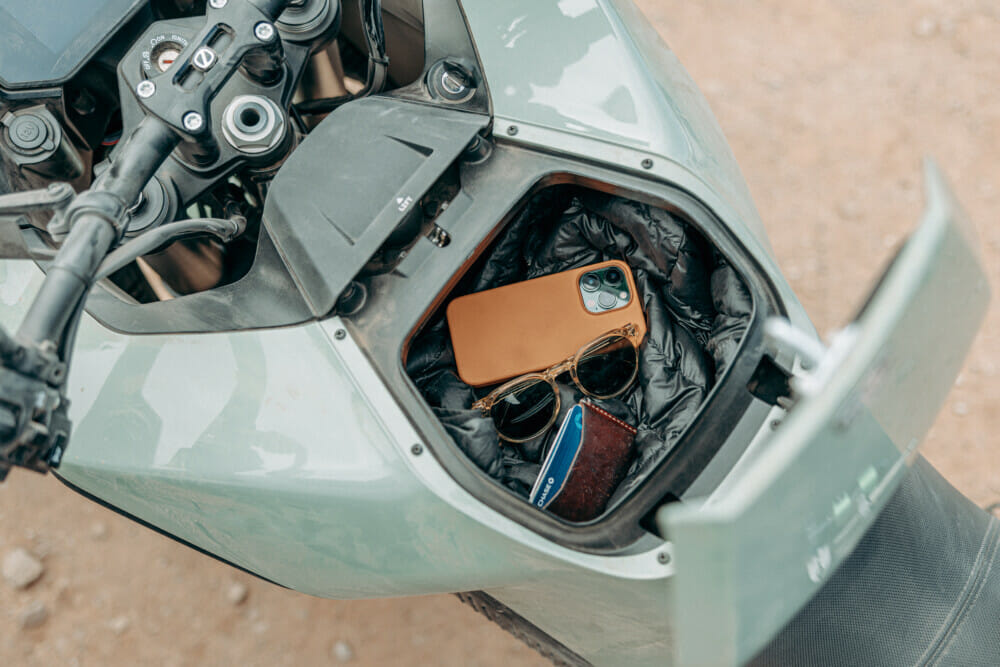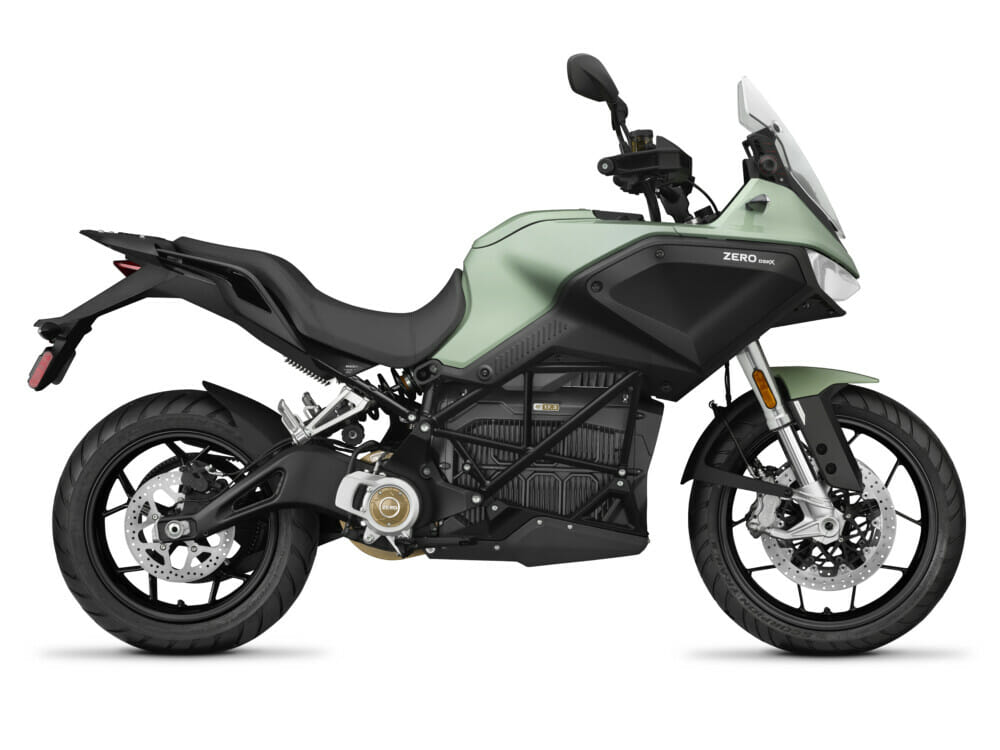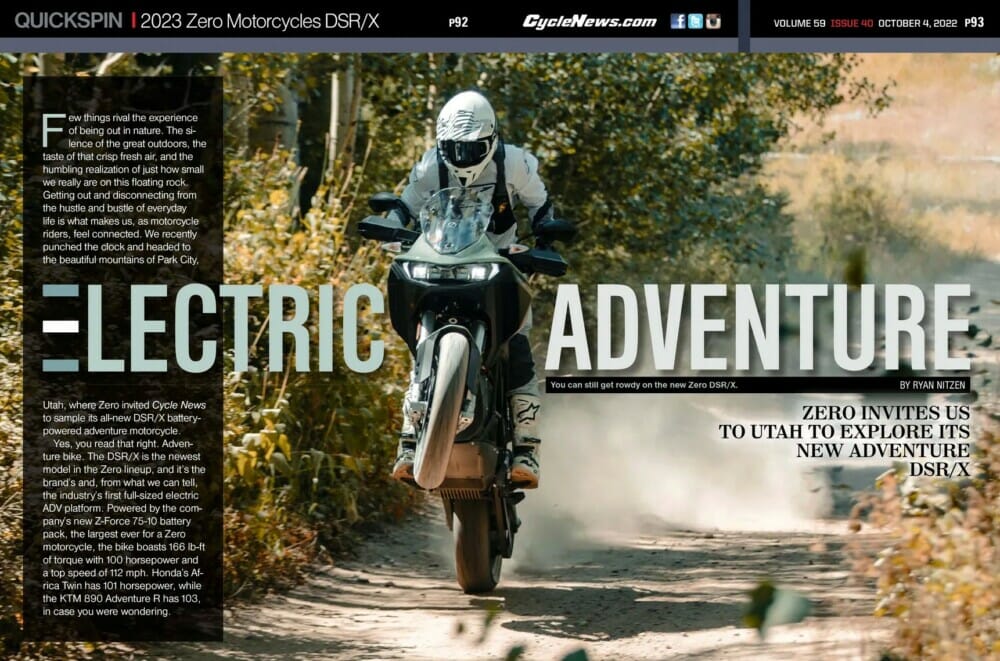Ryan Nitzen | October 8, 2022
Zero invites us to Utah to explore its new adventure DSR/X.
 You can still get rowdy on the new Zero DSR/X.
You can still get rowdy on the new Zero DSR/X.
By Ryan Nitzen
Few things rival the experience of being out in nature. The silence of the great outdoors, the taste of that crisp fresh air, and the humbling realization of just how small we really are on this floating rock. Getting out and disconnecting from the hustle and bustle of everyday life is what makes us, as motorcycle riders, feel connected. We recently punched the clock and headed to the beautiful mountains of Park City, Utah, where Zero invited Cycle News to sample its all-new DSR/X battery-powered adventure motorcycle.
Yes, you read that right. Adventure bike. The DSR/X is the newest model in the Zero lineup, and it’s the brand’s and, from what we can tell, the industry’s first full-sized electric ADV platform. Powered by the company’s new Z-Force 75-10 battery pack, the largest ever for a Zero motorcycle, the bike boasts 166 lb-ft of torque with 100 horsepower and a top speed of 112 mph. Honda’s Africa Twin has 101 horsepower, while the KTM 890 Adventure R has 103, in case you were wondering.
 You won’t hear it coming. The DSR/X’s electric powerplant is claimed to deliver 180 miles of range. We only rode it 60 miles.
You won’t hear it coming. The DSR/X’s electric powerplant is claimed to deliver 180 miles of range. We only rode it 60 miles.
ADV riding is known for eating up the miles, so range is important. Zero claims the bike’s 17.3-kilowatt-hour battery will get you 180 miles in the city and approximately 85 miles on the highway. Zero told us their testers can ride 200 miles of off-road trails at an, in their words, light to medium pace and about 155 miles at what they consider an aggressive pace. If accurate, that’s pretty darn good.
The belt-driven Zero DSR/X rides on cast 19- and 17-inch wheels with Showa suspension to match. Up front, you’ll find 47mm forks with adjustable spring preload, compression and rebound damping. Out back, there’s a Showa shock with a piggy-back reservoir and adjustable tool-less spring preload, compression and rebound damping. An easy-to-use twist-knob on the shock allows riders to dial in their preferred preload settings. Travel runs 7.48 inches front and rear.
 The bike works great on backroads and fire roads like this.
The bike works great on backroads and fire roads like this.
There’s no need for a clutch on an electric bike like this, but you will find a host of electronic integrations. Front and rear ABS, a smartphone app, and five unique ride modes are standard on the DSR/X. Each mode is fully tunable with on- and off-road designations and regeneration settings that work while off the throttle or under braking.
Since there’s no clutch or gears, Zero’s developed a new Vehicle Hold Control system that locks the brakes for three minutes when the bike is stopped on an incline. Simply squeeze the front brake for a few seconds while stopped and the computer will turn this auto-lock on. Pirelli Scorpion Trail II tires and four-piston J-Juan brakes do the dirty work while the rider sits atop the 32.6-inch seat height. All this weighs in at 544 pounds.
Zero wants to purify the adventure. No engine sound, no smell of exhaust, and no vibrations. Just you, the bike, and the road. And they nailed that part. You simply turn the bike on and go. No warming it up, no heading to the gas station. Simply get on and go. Starting with no sound is still taking some getting used to for me since the bike is on even without the rumbling of an engine. With purity in mind, we headed out from our Park City base camp and into the surrounding hillsides.
 Five different ride modes are available to the rider.
Five different ride modes are available to the rider.
Riding the DSR/X is smooth, like your favorite foamy latte. There is no vibration from the engine. So much about the bike is downright smooth, including throttle delivery. It’s by far the best I’ve felt from any electric bike. Most ride-by-wire systems feel vague with no real middle ground, either all the way on or all the way off, if you will. The Zero, however, feels very cable-esque and allows the rider to use some old-fashioned throttle control, which is great when transitioning from more traditional cable-operated dirt bikes.
Comparing an electric powerplant to a traditional gas powerplant is like comparing apples to oranges. Yes, they’re both bikes with motors, but the overall riding experience is entirely different. There’s no real bottom, mid, and top-end to speak of on an electric bike, and the lack of a shifter or a clutch furthers the distance of similarity. The power feels strong and continues to pull past the speed limit without any sign-off in sight. Riding the electric DSR/X is noticeably easy, too. Dare I say easier than internal combustion. Simple things like coming to a stoplight don’t require downshifting or pulling in the clutch. You never need to worry about stalling; you’re always in the right gear and the proper rpm range. You get the idea. Veteran riders won’t think these are big deals, but it does simplify the ride and is attractive for newbies.
 The “gas” tank now holds plenty of room for your stuff (but not a helmet).
The “gas” tank now holds plenty of room for your stuff (but not a helmet).
The ergos and riding position feel on par with other comparable adventure bikes like a Yamaha Tenere or Aprilia Tuareg. It’s wide up front, as expected, and the “gas tank” offers a little more than seven gallons of onboard storage. Hand guards and an adjustable windscreen are other accessories that come standard and are a must for ADV touring. Rider posture feels natural, and I expect it would be comfortable for much longer days in the saddle than we did. Our first ride only lasted a few hours, but the cockpit was easily adaptable. Even the standing position felt relatively neutral as we navigated casual fire roads.
Riding the bike off-road was the second half of the adventure. I turned off every rider assist possible and left the bike as raw as I could for the chattery dirt roads ahead. The electric motor is still super fun off-road as it winds up fast and gets up to speed with minimal input. The off-road riding modes are a must for this type of terrain because rider aids like traction control interfere with bumpy surfaces as soon as the rear wheel comes off the ground. Trying to push the bike’s limits in the dirt also reveals areas of needed improvement. With most of the weight centered down near the rider’s boots, the front end feels light and almost unstable at speed. I had to noticeably reduce my speed when entering turns to maintain control. The street-oriented tires didn’t do the bike any favors, either. The Zero will handle a light backroad cruise with ease, but more daring riders will quickly discover the bike’s limitations on the dirt, where it’s best to simply soak in and enjoy the scenery rather than seeing it whiz on past you out of the corner of your eyes.
Battery regeneration and riding modes are the final points of interest when riding the DSR/X. Each mode is like a power map and can be tuned to the rider’s liking. I preferred Canyon Mode, as it offered the most regen while riding. This regenerative energy came from the bike’s deceleration, which feels like engine braking. The designers did a great job with this “map” to make it feel like a natural riding experience. The spool of the wheels or energy created while braking recharges the battery while you ride and gives the rider a bit of extra juice. My only complaint about the ride modes was having to reset them every time the bike was turned off.
 Ergonomics are neutral and comparable to other gas-powered adventure bikes.
Ergonomics are neutral and comparable to other gas-powered adventure bikes.
As far as Zero’s range, I was unable to verify the numbers that we talked about earlier on this Zero-led-and-laid-out ride. Our ride burned up just 60 miles, approximately 75 percent of which was on paved roads at a mild pace and on one charge. When we returned to the hotel, my bike showed approximately 60 miles left on the battery.
The recharging process takes about two hours for a 95% charge on a level-two electric vehicle charger, but a full battery will take almost three, said the reps from Zero. The DSR/X comes with a standard level-one 110-volt wall charger, but a full charge from that will take about 10 hours. However, if the DSR/X can indeed get up to at least 150 miles on a charge as they say, I couldn’t help but wonder why they didn’t show off that capability and plan a longer ride for us. After all, we did come all this way, didn’t we? At 60 miles, I’m usually just getting warmed up when it comes to true adventure riding, especially in a place like Utah. So, for now, we’ll have to take Zero’s word for it regarding their range figures.
We’re at the point in this review where we must address the elephant in the room—the $24,495 price tag. I don’t have to tell you that that’s a lot of dough for a motorcycle, even if that does include a 6kW Rapid Charger System, heated grips, and aluminum bar ends. For comparison’s sake, $24,495 is equivalent to a BMW R 1250 GS Adventure, which comes with all the bells and whistles. At a claimed 544 pounds for the DSR/X, they also weigh in the same neighborhood.

So, is the Zero worth this kind of money? Well, that’s entirely up to you, of course. Who am I to tell you what your money is worth to you? But if silence is indeed golden and your idea of an adventure ride is limited to around 100 or so safe miles, then, okay, perhaps it is. I, however, am not entirely sold, at least not yet. Maybe when it’s proven to me that the DSR/X can indeed travel up to 100-150—even 200 miles on a single charge—I’d have a much better feel for it. Eeven then, what about the charging process? Am I going to have to carry a bulky and heavy charging system with me wherever I go, or plan my rides around Tesla charging stations? I’d have to live with the DSR/X for a while to find out. What do you say, Zero? I’m game.
Cost and range aside, however, the DSR/X is a fun motorcycle to ride; there is no denying that. And there are several things that stand out about the DSR/X, like that tremendous torque, overall smooth ride, and flat-out speed it delivers. It also quiet and handles well enough at casual speeds on the dirt. And e-motorcycles are simple to live with and, more importantly, cheap to maintain; the DSR/X should be no exception, and this might help take a big bite out of that $24, 495 price tag. CN

2023 Zero DSR/X Specifications
| MSRP: |
$24,495 |
| Engine Type: |
Battery-powered |
| Maximum Capacity: |
17.3 kWh |
| Normal Capacity: |
15.2 kWh |
| Peak Torque: |
166 ft-lb |
| Peak Horsepower: |
100 hp |
| Top Speed: |
112 mph |
| Charge Time: |
2.7 hours (110% charged) / 2.0 hours (95% charged) |
| Transmission: |
Clutchless, direct drive |
| Final Drive: |
22 / 90, Belt drive |
| Front Suspension: |
Showa 47mm Separate Function Cartridge Forks |
| Rear Suspension: |
Showa 46mm piston, piggy-back reservoir shock |
| Front-Wheel Travel: |
7.48 in. |
| Rear-Wheel Travel: |
7.48 in |
| Front Wheel: |
3 x 19 in. |
| Rear Wheel: |
5.4 x 17 in. |
| Front Tire: |
Pirelli Scorpion Trail II 120/70-19 in. |
| Rear Tire: |
Pirelli Scorpion Trail II 170/60-17 in. |
| Front Brake: |
Dual J-Juan radial 4-piston calipers with radial master cylinder, 320x5mm discs |
| Rear Brake: |
J-Juan 2x25mm piston floating caliper, 265×4.5mm disc |
| Wheelbase: |
60.0 in. |
| Rake: |
25° |
| Seat Height: |
32.6 in. |
| Weight (curb, claimed): |
544 lbs. |
